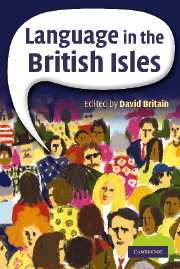Book contents
- Frontmatter
- Contents
- List of figures
- List of tables
- List of contributors
- Acknowledgements
- Map of the British Isles
- Introduction
- Part I English
- Part II The Celtic Languages
- 11 The history of the Celtic languages in the British Isles
- 12 Gaelic
- 13 Irish
- 14 Welsh
- Part III The Other Languages of the British Isles
- Part IV Applied Sociolinguistic Issues
- References
- Index
14 - Welsh
Published online by Cambridge University Press: 16 January 2010
- Frontmatter
- Contents
- List of figures
- List of tables
- List of contributors
- Acknowledgements
- Map of the British Isles
- Introduction
- Part I English
- Part II The Celtic Languages
- 11 The history of the Celtic languages in the British Isles
- 12 Gaelic
- 13 Irish
- 14 Welsh
- Part III The Other Languages of the British Isles
- Part IV Applied Sociolinguistic Issues
- References
- Index
Summary
Introduction
Welsh is a Celtic language, belonging to the Brythonic group along with Cornish (effectively extinct in the early nineteenth century, though spoken today by numbers of enthusiasts; see George 1993) and Breton (spoken in Brittany, see Stephens 1993, Humphreys 1993). Census figures (see National Statistics Online 2003) confirm that Welsh is the liveliest of the modern Celtic languages, both in terms of actual numbers of speakers (575,168), and in terms of percentage of speakers within the political boundaries of the country (20.5%). We will be looking in more detail at issues of language maintenance and language planning later in this chapter.
Welsh has also been subject to more linguistic research than other Celtic languages. A flavour of the studies undertaken in book form can be given here, the large numbers of journal articles being impossible to refer to. The phonetics of the language is the subject of a recent publication (Ball & Williams 2001), but there is also the traditional transcription primer of Jones (1926). Welsh phonology was the focus of a collection published in 1984 (Ball & Jones), while there have been several studies in a variety of theoretical approaches to syntax (for example, Awbery 1976, Jones & Thomas 1977, Sadler 1987, Rouveret 1994). Fife (1990) investigated the semantics of the verb, and a traditional descriptive grammar appeared in 1996 (Thomas) (though see also King 1993 and Williams 1980), while the mutations of Welsh were the focus of a study by Ball & Müller (1992).
- Type
- Chapter
- Information
- Language in the British Isles , pp. 237 - 254Publisher: Cambridge University PressPrint publication year: 2007
- 2
- Cited by

